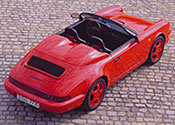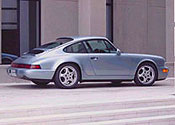



Porsche 964
87% new in components, the 964 Carrera 4 was definitely the most radically re-engineered 911 up to then. It had new front and rear suspensions, modern aerodynamics, an advanced electronic 4-wheel drive system and a heavily revised engine. Compare with the previous Carrera 3.2, the 964 in 1989 seemed like a revolution rather than evolution.
The monocoque chassis was basically unaltered, so was the general body shape that characterised 911 for a quarter of a century. However, the smooth, body-integrated and body-coloured front and rear bumpers indicated the great effort spent to aerodynamics. Instead of the predecessor's 0.42, the 964 achieved a remarkable drag coefficient of 0.32 while generating virtually no lift at high speed. Apart from bumpers,the flat undertrays which sealed front suspension, engine and transmission tunnel also played an important role to reduce drag and lift, so did the automatically raised rear spoiler which replaced a fixed wing. The little spoiler normally acted as ventilation for the engine and recessed smoothly on the engine lid. It raised at above 50 mph and dropped down (for the benefit of engine cooling) at under 6 mph.
 The
flat-six engine received so many modifications that it was given a new
name, M64 series. Its major mission was to comply with stricter emission
regulations, cope with the considerable weight increase of the 964 without
compromising performance. Moreover, it was designed to be a "world engine"
- suitable for all markets without any modifications. To achieve 250 hp
and 228 lbft output (up from Carrera 3.2s 231 hp and 210 lbft) even in
the presence of catalytic converter, it was bored and stroked to 3.6 litres
and employed a very high compression ratio of 11.3:1 which was made possible
by twin-spark per cylinder and knock sensor. Advanced Motronic program
worked in associate with ignition and sequential fuel injection. A 2-stage
resonance intake manifold was introduced to improve mid to high speed
power. That enabled the Carrera 4 to sprint to 60 mph in 5.2 sec, slightly
quicker than its predecessor. That was very respectable, considering the
car weighed an astonishing 250 kg more. It topped 161 mph, which actually
matched the contemporary 911 Turbo 3.3, thanks to superior aerodynamics.
The
flat-six engine received so many modifications that it was given a new
name, M64 series. Its major mission was to comply with stricter emission
regulations, cope with the considerable weight increase of the 964 without
compromising performance. Moreover, it was designed to be a "world engine"
- suitable for all markets without any modifications. To achieve 250 hp
and 228 lbft output (up from Carrera 3.2s 231 hp and 210 lbft) even in
the presence of catalytic converter, it was bored and stroked to 3.6 litres
and employed a very high compression ratio of 11.3:1 which was made possible
by twin-spark per cylinder and knock sensor. Advanced Motronic program
worked in associate with ignition and sequential fuel injection. A 2-stage
resonance intake manifold was introduced to improve mid to high speed
power. That enabled the Carrera 4 to sprint to 60 mph in 5.2 sec, slightly
quicker than its predecessor. That was very respectable, considering the
car weighed an astonishing 250 kg more. It topped 161 mph, which actually
matched the contemporary 911 Turbo 3.3, thanks to superior aerodynamics.
For the first time, the 911 received a proper MacPherson strut suspension with concentric coil spring instead of torsion bars. As earlier we have mentioned, the original 911 chose torsion bar in order to give more luggage room at the front. However, as Carrera 4 had the 4WD system already engaged a lot of space, there was no reason to maintain the torsion bar setup. At the rear, a revision of geometry to the semi-trailing arms, plus addition of rubber bushing to pivot joints, enabled a passive rear-wheel steer (inspired by 928s Weissach axle) to counter the oversteering. The new trailing arm was also made in cast aluminium instead of iron. However, the biggest technology breakthrough must be the intelligent 4-wheel drive, which was simplified from the 959. It normally transferred 69% torque to the rear axle, but in case of slide, the electronic control could send more to the wheels which had most traction. Active rear LSD also keep oversteer tightly in check. It was so effective that, accompany with the changes in suspension geometry, many 911 traditionalists criticised it as an understeerer!
964 Porsche VIN (Vehicle Identification Number)
The easiest way to correctly identify a 964 is to check the vehicle identification number (VIN). The VIN is a 17 digit international code. Porsche use two versions, the ROW and the USA requirements code.
In reading the following VIN numbers please note that the first 6 characters have been removed eg. WPOZZZ for RoW cars, and USA and Canadian cars WPOAAO/WPOAEO.
It is much easier to identify an American 964 as compared to a ROW 964. The following brief explanation of key digits within the VIN will ensure correct identification of type and for the US version more detail can be extracted. This is very important when trying to determine if a 964 is genuine and the model is actually manufactured by Porsche and is not an aftermarket conversion.
Digit 4 Z = ROW market, A = Coupe (USA), B = Targa (USA), C = Cabriolet, Speedster (USA)
Digit 5 Z = ROW, A = 3.3 litre turbocharged engine, B = 3.6 litre normally aspirated engine, C = 3.6 litre turbocharged engine
Digit 6 Z = ROW, 0 = No airbags installed, 2 = airbags installed
Digits 7 and 8 First two numbers of the type (auftragsnummer) number. In all cases for the 964 these numbers will be 96
Digit 9 is a check number and is not important. However for the USA this will be a 0 to 9 or a X and for the ROW will be a Z.
Digit 10 is the model year letter. K = 1989, L = 1990, M = 1991, N = 1992, P = 1993, R = 1994
Digit 11 is the plant of origin i.e "S" for Stuttgart
Digit 12 is the last number of the type and this will always be a 4.
Digits 13 to 17 make up the serial number.
Digit 13 1 = RS America, 2 = US Coupe with airbags, 4 = US Targa with airbag, 6 = US Cabriolet with airbag
Digit 13 also provides version identification but can only be used for a specific model year. The numbers were changed around so a 5 in 1989 may not be the same as a 5 in 1994.
The use of this data is extremely important especially if the 964 being offered is not contained in the list of models found in the timeline section. A number of turbocharged cabriolets are being claimed as factory produced. Their VINs do not support this claim apart from the fact that such a model does not appear in the records of Porsche production for the 964.
Another issue which causes identification problems is the chassis number. This is found on a plate directly below the fuel tank in the luggage compartment. This number will always start WP0 regardless of version. The important point is that the last five digits of the chassis number match the serial number of the VIN.
over
52,000 964 chassis' were built.
964 Production numbers:
15121
were 964 C4 89-94
701 were RS Americas between 92-93
297 were 964 Cup cars between 90-94
936 were Speedsters, 427 are US models, 14 built as RHD 93-94
20 were 964 C4 Lightweights 91
2398 were 964 RS between 91-9
80 were Turbo S between 92-93
20 were Turbo S2 made in 92 to satisfy IMSA Supercar Series homologation
95 were 964 Carrera RS 3.8 built in 94
63 were 964 Turbo 3.6 built in 94
handful of 964 Turbo 3.6 Lightweights, as well as Slantnose Specialsbo
copyright © 2003-2015 Lüfteknic | privacy | web terms | sale terms | info@lufteknic.com